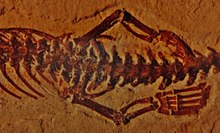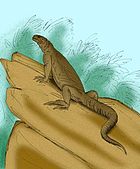Extinct genus of lizard
| Tetrapodophis Temporal range: Early Cretaceous, Latest Aptian, ~115–113 Ma PreꞒ Ꞓ O S D C P T J K Pg N ↓ | |
|---|---|

| |
| Fossil in Bürgermeister-Müller-Museum | |
| Scientific classification | |
| Domain: | Eukaryota |
| Kingdom: | Animalia |
| Phylum: | Chordata |
| Class: | Reptilia |
| Order: | Squamata |
| Clade: | Toxicofera |
| Genus: | †Tetrapodophis Martill et al., 2015 |
| Type species | |
| †Tetrapodophis amplectus Martill et al., 2015 | |
Tetrapodophis (Greek meaning "four-footed snake") is an extinct genus of lizard from the Early Cretaceous (Aptian) aged Crato Formation of Brazil. It has an elongated snake-like body, with four disproportionately short limbs.
Tetrapodophis has been considered by some authors to be one of the oldest members of Ophidia; the taxonomic group which includes snakes and some of their closest extinct relatives. However, this classification has been disputed by some other authors, who identify Tetrapodophis as a dolichosaurid. The exact phylogenetic placement of Dolichosauridae is also disputed. Dolichosaurids could be related to Ophidia, which would mean that Tetrapodophis is indeed related to snakes, albeit more distantly than previously thought. Alternatively, Dolichosaurids could be more closely related to Mosasaurs.
Description


Tetrapodophis possesses small yet well-developed fore- and hindlimbs like a lizard and a long body similar to a snake, around 19.5 cm (7.7 in) in length. Nevertheless, it shares many characteristics with modern snakes, including an elongate body, short tail, broad belly scales, a skull with a short snout and long braincase, curved jaws, and sharp hooked teeth. BMMS BK 2-2 contains bones of another animal in its gut, indicating that Tetrapodophis was carnivorous like most snakes. Other features such as short neural spines suggest that Tetrapodophis was adapted to burrowing, lending support to the hypothesis that snakes evolved in terrestrial environments (another hypothesis posits that they evolved in aquatic environments). The high number of vertebrae (upwards of 150) in Tetrapodophis and snakes is not seen in other burrowing reptiles with elongate bodies and reduced or absent limbs, meaning that it is most likely not an adaptation for a serpentine form of movement.
Discovery and controversy
The type species, Tetrapodophis amplectus, was named in 2015 on the basis of a complete skeleton (BMMS BK 2-2) preserved on a limestone slab in the Bürgermeister Müller Museum in Solnhofen, Germany, which was labeled as "unknown fossil" until its importance was recognized by paleontologist David Martill when he visited Germany in 2012, and housed in a private collection in a private in a museum in Solnhofen. The fossil had been in the hands of the private collector for "several decades" prior to the publication. While no locality information was provided for the specimen, based on characteristics of the rock it is thought to come from the Early Cretaceous Crato Formation of Northeast Brazil. Brazil's laws do not allow the removal of fossils from its territory since 1942, nor that studies on them be conducted without the participation of at least one Brazilian scientist. Due to a lack of information regarding the provenance of the fossil, it was possible that the fossil had been illegally exported from Brazil. This caused controversy among Brazilian paleontologists, and sparked a legal investigation by the Brazilian government. According to lead author Martill, fossils from the Crato Formation are widely illegally collected and exported from Brazil due to corruption in the country, and are found in fossil shops and museums all over the world, and that if current regulations were followed many fossils would simply be destroyed rather than collected.
When the fossil was collected is unknown. Dave Martill asserted in an interview to a Brazilian journalist that it was possible that the fossil was exported prior to 1942, but stated that ultimately he didn't "care a damn how the fossil came from Brazil", saying that it was irrelevant to its scientific significance. Martill stated that he was "critical of all laws that interfere with the science of paleontology; and blanket bans on fossil collecting are indiscriminatory and only hinder science ... They also lead to xenophobia -- Brazil fossils for Brazilians, British fossils for Brits. It should be fossils for all. No countries existed when the animals were fossilized." When asked why he did not include a Brazilian scientist on the study, Martill remarked that he was unaware of any Brazilian snake researchers when writing the study (though he later became aware of one following the controversy), but followed with "But what difference would it make? I mean, do you want me also to have a black person on the team for ethnicity reasons, and a cripple and a woman, and maybe a homosexual too just for a bit of all round balance? … If you invite people because they are Brazilian then people will think that every Brazilian author on a scientific paper is there because he is Brazilian and not because he is a clever scientist." Martill remarked several years later in 2020 that he felt his comments in the interview were poorly worded. Nicholas Longrich, a co-author of the study, remarked that he would like to see the fossil returned to Brazil.
Aside from the export issues, the fact that the specimen was in a private collection when described also caused controversy, and the owner of the fossil reportedly made it difficult for later researchers to study the specimen. In 2024, the fossil of Tetrapodophis was donated to National Museum of Brazil.
Classification
A phylogenetic analysis published alongside the original 2015 description of Tetrapodophis places it as a close relative of other lizards, but outside the crown group Serpentes, meaning that Tetrapodophis branched off before the most recent common ancestor of all living snakes. Below is a cladogram from that analysis:
| Squamata |
| |||||||||||||||||||||||||||||||||||||||||||||||||||||||||||||||||||||
The interpretation of Tetrapodophis amplectus as an early fossorial snake was challenged by Caldwell et al. (2016), who considered it more likely to be a dolichosaurid squamate related to mosasaurs. A position supported by later analysis in 2018 and in 2021.
Cladogram after Caldwell et. al. 2021:
| |||||||||||||||||||||||||||||||||||||
However, a study in 2023 again supported its position as a stem-snake, finding it to be unrelated to mosasaurs.
References
- ^ David M. Martill; Helmut Tischlinger; Nicholas R. Longrich (2015). "A four-legged snake from the Early Cretaceous of Gondwana". Science. 349 (6246): 416–419. Bibcode:2015Sci...349..416M. doi:10.1126/science.aaa9208. PMID 26206932. S2CID 25822461.
- ^ Lee, Michael S. Y.; Palci, Alessandro; Jones, Marc E. H.; Caldwell, Michael W.; Holmes, James D.; Reisz, Robert R. (1 November 2016). "Aquatic adaptations in the four limbs of the snake-like reptile Tetrapodophis from the Lower Cretaceous of Brazil". Cretaceous Research. 66: 194–199. Bibcode:2016CrRes..66..194L. doi:10.1016/j.cretres.2016.06.004. ISSN 0195-6671.
- ^ Zaher, Hussam; Mohabey, Dhananjay M; Grazziotin, Felipe G; Wilson Mantilla, Jeffrey A (28 February 2023). "The skull of Sanajeh indicus , a Cretaceous snake with an upper temporal bar, and the origin of ophidian wide-gaped feeding". Zoological Journal of the Linnean Society. 197 (3): 656–697. doi:10.1093/zoolinnean/zlac001. ISSN 0024-4082.
- ^ Michael W. Caldwell; Robert R. Reisz; Randall L. Nydam; Alessandro Palci; Tiago R. Simões (2016). "Tetrapodophis amplectus (Crato Formation, Lower Cretaceous, Brazil) is not a snake". Society of Vertebrate Paleontology 76th Annual Meeting Program & Abstracts: 108. Archived from the original on 18 October 2016. Retrieved 30 October 2016.
- ^ Paparella, Ilaria; Palci, Alessandro; Nicosia, Umberto; Caldwell, Michael W. (June 2018). "A new fossil marine lizard with soft tissues from the Late Cretaceous of southern Italy". Royal Society Open Science. 5 (6): 172411. Bibcode:2018RSOS....572411P. doi:10.1098/rsos.172411. ISSN 2054-5703. PMC 6030324. PMID 30110414.
- ^ Michael W. Caldwell; Tiago R. Simões; Alessandro Palci; Fernando F. Garberoglio; Robert R. Reisz; Michael S. Y. Lee; Randall L. Nydam (2021). "Tetrapodophis amplectus is not a snake: re-assessment of the osteology, phylogeny and functional morphology of an Early Cretaceous dolichosaurid lizard". Society of Vertebrate Paleontology, Latest Articles. 19 (13): 893–952. Bibcode:2021JSPal..19..893C. doi:10.1080/14772019.2021.1983044. S2CID 244414151.
- Alessandro Palci; Michael W. Caldwell (2010a). "Redescription of Acteosaurus tommasinii von Meyer, 1860, and a discussion of evolutionary trends within the clade Ophidiomorpha". Journal of Vertebrate Paleontology. 30 (1): 94–108. doi:10.1080/02724630903409139. S2CID 85217455.
- Michael W. Caldwell; Alessandro Palci (2010b). "A new species of marine ophidiomorph lizard,Adriosaurus skrbinensis, from the Upper Cretaceous of Slovenia". Journal of Vertebrate Paleontology. 30 (3): 747–755. doi:10.1080/02724631003762963. S2CID 85570665.
- Augusta, Bruno G.; Zaher, Hussam; Polcyn, Michael J.; Fiorillo, Anthony R.; Jacobs, Louis L. (11 August 2022), Gower, David J.; Zaher, Hussam (eds.), "A Review of Non-Mosasaurid (Dolichosaur and Aigialosaur) Mosasaurians and Their Relationships to Snakes", The Origin and Early Evolutionary History of Snakes (1 ed.), Cambridge University Press, pp. 157–179, doi:10.1017/9781108938891.011, ISBN 978-1-108-93889-1
- Yong, Ed (23 July 2015). "A Fossil Snake With Four Legs". Phenomena: Not Exactly Rocket Science. National Geographic. Retrieved 24 July 2015.
- ^ Christakou, Anastasia (4 August 2015). "Four-legged snake fossil sparks legal investigation". Nature. doi:10.1038/nature.2015.18116. ISSN 1476-4687.
- ^ Four-legged snake fossil stuns scientists—and ignites controversy (Report). 18 October 2021. doi:10.1126/science.aac8899.
- ^ "Author of 4-legged-snake paper defies Brazilian fossil laws". Herton Escobar (in Brazilian Portuguese). Retrieved 16 December 2020.
- Martill, David (November 2011). "Protect - and die". www.geolsoc.org.uk. The Geological Society of London. Retrieved 9 May 2024.
- Elbein, Asher (22 March 2021). "Decolonizing the Hunt for Dinosaurs and Other Fossils". The New York Times. ISSN 0362-4331. Retrieved 26 June 2021.
- Cisneros, Juan Carlos; Raja, Nussaïbah B.; Ghilardi, Aline M.; Dunne, Emma M.; Pinheiro, Felipe L.; Regalado Fernández, Omar Rafael; Sales, Marcos A. F.; Rodríguez-de la Rosa, Rubén A.; Miranda-Martínez, Adriana Y.; González-Mora, Sergio; Bantim, Renan A. M.; de Lima, Flaviana J.; Pardo, Jason D. (2022). "Digging deeper into colonial palaeontological practices in modern day Mexico and Brazil". Royal Society Open Science. 9 (3). doi:10.1098/rsos.210898. ISSN 2054-5703. PMC 8889171. PMID 35291323.
- Malleret, Constance (7 May 2024). "'Magical moment' as fire-ravaged Brazil museum receives big fossil donation". The Guardian. ISSN 0261-3077. Retrieved 8 May 2024.
- Geggel, Laura (28 October 2016). "Mistaken Identity? Debate Over Ancient 4-Legged Snake Heats Up". Live Science.
External links
 Media related to Tetrapodophis at Wikimedia Commons
Media related to Tetrapodophis at Wikimedia Commons- Tetrapodophis as it may have been in life
- Scientists Discover Four-Legged Snake Fossil. On: SciTechDaily, Source: University of Portsmouth. 2 August 2015
- Susan Evans: "Four legs too many?," In: Science Vol. 349 no. 6246 pp. 374–375. 24 July 2015; doi:10.1126/science.aac5672
| Taxon identifiers | |
|---|---|
| Tetrapodophis | |




